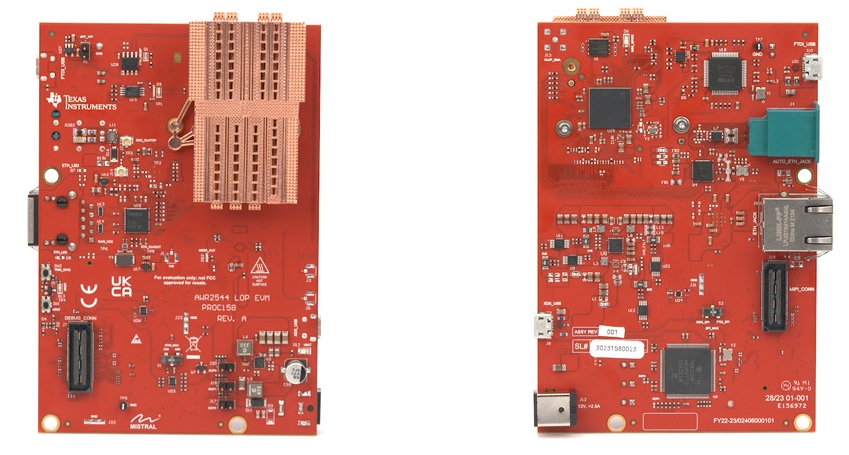Safety has become an integral feature of today's vehicles as safety ratings and regulations from the Global New Car Assessment Programme (Global NCAP) have become more stringent on active safety features. Global automakers continue to enhance the Advanced Driver Assistance Systems (ADAS) features in their vehicles, including Automatic Emergency Braking (AEB), Adaptive Cruise Control (ACC), and Advanced Lane Centering, to meet these safety requirements and aim for higher levels of autonomous driving. The number of radar sensors around the vehicle is increasing in order to support these functions and meet safety regulations.
Evolving Automotive Architecture
One of the ways that automotive system designers are addressing the implementation of ADAS functionality is by reconsidering the structure and integration of electrical and electronic system architectures. Today's typical architecture is the edge architecture, which consists of highly intelligent radar sensors that stream processed data to the ADAS electronic control unit (ECU) via the controller LAN or 100Mb Ethernet interface. Designed for high performance, these sensors contain a processor and a dedicated gas pedal for performing distance, Doppler and angular Fast Fourier Transforms (FFTs), as well as subsequent advanced algorithms for object detection, classification and tracking. The final object data from each edge radar sensor is then sent to the ADAS ECU.Figure 1 illustrates the edge architecture.


Figure 1: Radar sensors in the edge architecture connected to the ADAS ECU.
Edge architectures are evolving and giving way to satellite architectures, where sensor sensors scattered around the vehicle stream pre-processed distance FFT data over a high-speed 1Gb Ethernet interface to a powerful central ECU. a significant portion of the data processing is transferred to the central ECU (Figure 2). Unlike edge architectures, where a single radar sensor performs all data processing independently, satellite architectures allow centralized data processing using minimally processed data at the central processor.


Figure 2: Radar sensors in the satellite architecture connected to the central ECU.
Advantages of the satellite architecture
Centralized processing enables effective sensor fusion algorithms for more accurate decision making. Just as the human brain makes decisions based on what both eyes see, rather than making decisions based on what each eye sees independently. Original Equipment Manufacturers (OEMs) can deploy algorithms for improved angular resolution (distributed aperture radar) and maximum speed, and even machine learning algorithms for object classification. The fusion of sensor inputs with these algorithms improves detection performance and produces relatively accurate perceptual maps. For automakers, this means increased levels of autonomy. For drivers and passengers, it means safer cars.
In addition, the use of satellite radar sensors allows for system scalability and modularity. Many ADAS applications can be realized if the sensors can be placed in more convenient locations around the car. Coverage can be adjusted simply by changing the number or configuration of sensors, thus expanding a single platform from cost-sensitive low-end vehicles to differentiated high-end vehicles with varying levels of autonomy.
The satellite architecture adds value through sensor fusion algorithms and greater computing power in the central ECU. Satellite sensors and differentiated features simplified through software help reduce system complexity and provide new ways to create value. In addition, with satellite radar, automakers have the option of using over-the-air software updates to improve system performance and enhance safety. The combination of performance, scalability and simplicity highlights the prominence of satellite architectures in the automotive industry.
Radar Sensors Designed for Satellite Architecture
Texas Instruments Incorporated (TI) has designed the AWR2544 on-chip radar sensor specifically for satellite architectures. It features an integrated 77 GHz transceiver with four transmitters and four receivers to provide greater range detection and improved performance. It also includes a cost-optimized radar processing gas pedal and a throughput-enhanced 1Gbps Ethernet interface for generating and streaming distance FFT compressed data. The device is Automotive Safety Integrity Level B compliant and provides a safe execution environment with a hardware safety module.
The device is also designed with TI's Load-on-Package (LOP) technology, which transmits signals directly from the package radiator to the 3D antenna via waveguides within the printed circuit board (PCB). Figure 3 illustrates the AWR2544LOP evaluation module with a 3D waveguide antenna.

Figure 3: AWR2544LOP EVM
At the system level, LOP technology improves performance by increasing signal-to-noise ratio, simplifies thermal management, reduces cost by avoiding the use of expensive RF PCB materials, and increases flexibility by enabling PCB reuse in multiple sensor designs.
TI also offers compatible security enhancements and optimized power management ICs to simplify system implementation. The LP87725-Q1 features three low-noise step-down converters, a low dropout regulator, and a load switch to power the AWR2544-based satellite architecture, as well as an Ethernet physical layer.
Conclusion
ADAS applications continue to evolve to meet increasing levels of autonomy and safety requirements. As new architectures, such as satellite-based architectures, emerge, the detection and processing technologies in these systems must evolve to support the new capabilities. Devices such as the AWR2544 radar sensor not only give automotive system designers the flexibility to embrace these trends, but also help create safer, smarter vehicles for everyone.
More news about ADAS can be found at perceptive-ic..



























